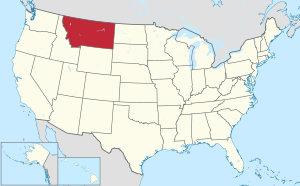|
Big Horn County, Montana
Big Horn County is a county located in the U.S. state of Montana. As of the 2020 census, the population was 13,124.[1] The county seat is Hardin.[2] The county, like the river and the mountain range, is named after the bighorn sheep in the Rocky Mountains.[3] The county was founded in 1913.[4] It is located on the southern boundary of the state. Most of the area is part of the Crow Indian Reservation. Reservation poverty affects the county, which is the second-poorest county in the state. HistoryOn June 25, 1876, the Battle of Little Bighorn began. The Battle is also known as the Battle of the Greasy Grass to the Lakota and other Plains Indians.
Law and governmentThe county has several jurisdictions, each with its own regulations and law enforcement agencies. The Crow and Northern Cheyenne Indian Nations are administered by the tribes. Little Bighorn Battlefield and the Big Horn Canyon National Recreation Area are regulated by the National Park Service. The remainder of the county falls under the State of Montana. GeographyAccording to the United States Census Bureau, the county has a total area of 5,015 square miles (12,990 km2), of which 4,995 square miles (12,940 km2) is land and 19 square miles (49 km2) (0.4%) is water.[5] It is the fifth-largest county in Montana by land area. Most of the county's land area is Indian reservations: The Crow Indian Reservation covers 64.2 percent of its area, while the Northern Cheyenne Indian Reservation covers another 6.37 percent. The county is home to the Big Horn, Pryor and Wolf mountain ranges. Major highwaysAdjacent counties
National protected areasClimateAccording to the Köppen Climate Classification system, Big Horn County has a semi-arid climate, abbreviated "BSk" on climate maps.[6] PoliticsBig Horn County is generally Democratic, owing largely to its majority Native American population. It is distinguished from most other counties in rural Montana, which often lean heavily Republican. In 2024, Donald Trump carried the county by a narrow plurality, the first time a Republican won the county since Reagan in 1980.
Demographics
2020 censusAs of the 2020 census, there were 13,124 people living in the county.[13] 2010 censusAs of the 2010 census, there were 12,865 people, 4,004 households, and 2,970 families living in the county. The population density was 2.6 inhabitants per square mile (1.0/km2). There were 4,695 housing units at an average density of 0.9 units per square mile (0.35 units/km2). The racial makeup of the county was 64.3% American Indian, 31.4% white, 0.5% Asian, 0.2% black or African American, 1.0% from other races, and 2.6% from two or more races. Those of Hispanic or Latino origin made up 4.0% of the population. In terms of ancestry, 12.1% were American, and 10.3% were German. Of the 4,004 households, 45.6% had children under the age of 18 living with them, 48.8% were married couples living together, 17.3% had a female householder with no husband present, 25.8% were non-families, and 23.0% of all households were made up of individuals. The average household size was 3.18 and the average family size was 3.77. The median age was 30.5 years. The median income for a household in the county was $36,550 and the median income for a family was $41,985. Males had a median income of $32,216 versus $27,917 for females. The per capita income for the county was $15,066. About 20.7% of families and 23.5% of the population were below the poverty line, including 32.4% of those under age 18 and 15.4% of those age 65 or over. EconomyCoal mining and agriculture play major roles in Big Horn County's economy. Farms and ranches in the county produce mainly beef cattle, sugar beets, alfalfa, and small grains.[14] CommunitiesCity
TownCensus-designated placesUnincorporated communitiesFormer communitiesSee also
References
External linksWikimedia Commons has media related to Big Horn County, Montana. |
|||||||||||||||||||||||||||||||||||||||||||||||||||||||||||||||||||||||||||||||||||||||||||||||||||||||||||||||||||||||||||||||||||||||||||||||||||||||||||||||||||||||||||||||||||||||||||||||||||||||||||||||||||||||||||||||||||||||||||||||||||||||||||||||||||||||||||||||||||||||||||||||||||||||||||||||||||||||||||||



